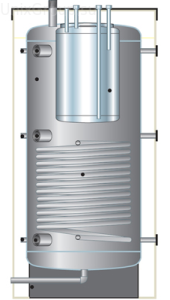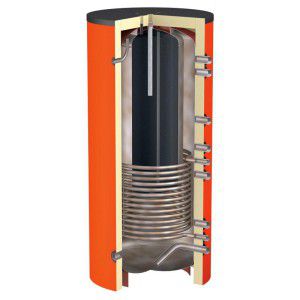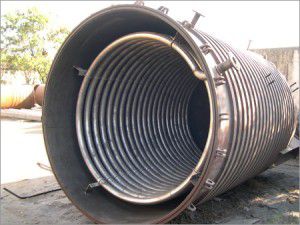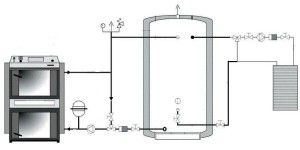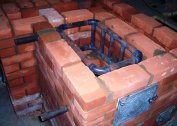A modern heating system should not only maintain a comfortable temperature level during the operation of the boiler, but also after that. The decrease in the temperature of the coolant in the pipes occurs relatively quickly, so it is necessary to install additional devices. The best way to do this in this regard is the heating system with a heat accumulator with your own hands: a circuit, calculation, the connection of which can be done for almost any autonomous complex.
The principle of operation of the heat accumulator
The heat accumulator is a large tank filled with water. It is heated from the heating system directly or indirectly. As a result, the water temperature rises to the maximum value. When the boiler stops working, the reverse process occurs - the energy from the heated water is transferred to the coolant.
To accomplish this task, the connection to the heating system of the heat accumulator must be carried out at the closest possible distance from the boiler outlet pipe. In addition, the following design requirements are imposed:
- Correctly calculate the volume. It directly depends on the area of the heated room;
- Thermal insulation of the walls. This is necessary to reduce heat loss in order to ensure maximum heat capacity;
- Possibility of an additional function of hot water supply (DHW).
Such a heating system with a heat accumulator can provide a reduction in fuel consumption by up to 30%.
The level of comfort is significantly increased, which is expressed in maintaining the optimum temperature for a long time even when the boiler is idle.
However, before planning the manufacture and installation of a heat accumulator, one should take into account such negative factors:
- Decrease in efficiency. Since part of the energy from the coolant will be spent on heating the water, the temperature in the radiators will be lower than without the heat accumulator;
- An effective home-made heating accumulator for heating is relevant only for systems with a high temperature operating mode - from 80/60. Otherwise, heat loss due to water heating will significantly reduce the degree of air heating in the rooms;
- Large capacity capacity. To accumulate sufficient energy should choose large-capacity heat accumulators. Only in this way will their work be truly effective.
Before self-manufacturing, you must first determine the optimal design.
Model Overview
As a basis for a home-made heating accumulator, you can consider the standard factory model. It is a container with several connections for connection. Inside there is a pipeline in the form of a spiral through which the coolant flows. The pipe material is copper or galvanized steel.
To increase work efficiency, the design provides an additional heating element - an electric heater.
It serves as an alternative source of thermal energy to maintain the temperature of the water in the tank at the right level. Particular attention should be paid to the design, and in particular to ensuring maximum thermal insulation. It consists of two walls, between which there is a layer of insulation. Most often this is basalt wool. As a result, such a heat accumulator for heating boilers has the following positive qualities.
- Uniform heating of water in the total volume;
- The possibility of the functioning of heating systems with the help of a heating element even with the boiler not working;
- Minimum heat loss from the walls of the housing.
However, the cost of such a design is high, and its independent manufacture is problematic due to complexity. Therefore, another heating scheme with a heat accumulator is most often used.
In this case, the design is a container in which a spiral heating pipe is installed. It has four branch pipes for a direct and return pipe - entering and leaving. Its manufacture is much simpler than for the above model. To do this, it is enough to weld the container and make the corresponding nozzles in it.
If a heating system with a heat accumulator with your own hands does not provide for the connection of additional sources of energy intake according to the scheme and calculation, you should consult specialists on this issue.
One of the advantages of this design is the low complexity of the work. But it is less effective, which affects the cooling time of the water. It can be upgraded - install an electric heater. A similar heating system with a small heat accumulator will work even without a boiler. But in this case, electricity costs will increase significantly. It is not recommended to use the DHW system, since the reduction in the efficiency of the installation will be large.
Calculation of heat storage capacity
The main technical parameter of the heat accumulator is its usable volume. The amount of thermal energy that can accumulate in water depends on this.
The correct calculation of the heat accumulator for heating begins with an analysis of the room.
First, its area is determined, based on which the minimum power value necessary to heat all rooms for one hour is calculated. This is done using the following formula:
Q = S / 10
Where Q - this is the heat loss of the building or the amount of energy to compensate for it,S - area of the house.
For a room of 90 m² it is necessary to generate 9 kW of energy per hour. Next, calculate the amount of stored energy in the heat accumulator for heating per 1 m³ of water. This indicator depends on its temperature. To avoid lengthy calculations, the table shows data for various values of the energy return from the coolant to water in the tank.
| Temperature ° C | Energy kWh |
| 90/70 | 23,26 |
| 80/50 | 34,89 |
| 70/55 | 17,45 |
| 80/30 | 58 |
Assume that the standard heating temperature of 80/30 is applied. In this case, when calculating the heat accumulator for heating, designed for efficient operation for 12 hours, the total usable volume will be equal to:
V = 12 * 9 / (58) = 1.86 m³
To fill such a volume, it will be necessary to produce a cylindrical structure with a radius of 1 m and a height of 2.3 m.
Making a heat accumulator with your own hands
Is it possible to make a heat accumulator for heating with your own hands? To do this, you need to make a design with a calculated volume. It is best to use thick-walled galvanized steel. Since the dimensions of the future type of battery are quite large, welding work should be entrusted to professionals. Any defect in the seam can lead to sad consequences - depressurization of the entire structure.
To improve the strength characteristics, it is recommended to produce a two-layer container. The material of the inner layer must not corrode under the influence of water and high temperatures. The outer shell must fulfill the functions of mechanical protection. It is also necessary to choose the right diameter of the pipes so that the heat accumulator is connected to the heating system without additional adapters.
The work can be divided into the following stages:
- The manufacture of the internal pipeline. It is best to do U-shaped, while the height should be 5-7 cm less than the capacity;
- Welding the inner cylinder.It should have holes for the nozzles;
- The manufacture of the outer cylinder.
After the manufacture of a heat accumulator for the heating system with your own hands has been completed - it is necessary to check its strength. To do this, the structure is filled with water and visually observe for the absence of leaks or depressurization.
To improve the insulating qualities, the outer wall is insulated with basalt wool. In this case, the efficiency of the heating system with a heat accumulator will increase significantly, since heat losses will be minimal. The thickness of the protective layer must be at least 50 mm.
Installation features and storage tank connection diagram
To connect the heat accumulator to the heating system, it is necessary to choose its location correctly. It is best if he will stand in the immediate vicinity of the boiler. In this case, the temperature of the coolant will be high, which will positively affect the heating rate of water in the tank.
You should also make a pedestal for it, since the total mass of the filled heat accumulator will be quite high. In our case, it will be approximately 2.1 tons. In a private house, a separate foundation must be prepared for this. If a hot water supply is provided in the heating system with a heat accumulator, a water supply should be made in the room. It connects to the tank through shutoff valves. Alas, there are no general schemes for the manufacture of a heat accumulator for heating. Most often guided by personal experience.
Practical tips
Based on the numerous experience in manufacturing home-made batteries for heating, several recommendations can be made:
- Instead of a factory coil, a steel corrugated hose can be used. Then the total heat transfer area will increase;
- In order not to make a steel structure, plastic containers of an appropriate volume can be used. To maintain their shape, they must be enclosed in a lattice frame;
- Small heat accumulators for heating can be used to fuel the underfloor heating system.
But for a large area of the room, it is still recommended to purchase factory models, since their strength and functionality were calculated by specialists.
When choosing ready-made heat accumulators for any heating boiler, pay attention to the number of inlet and outlet pipes. The ability to connect the device to a hot water supply system, a warm floor, or the use of an alternative source of heating water - a solar collector - depends on this.
The video demonstrates the operation of the heat accumulator paired with a heating boiler:
